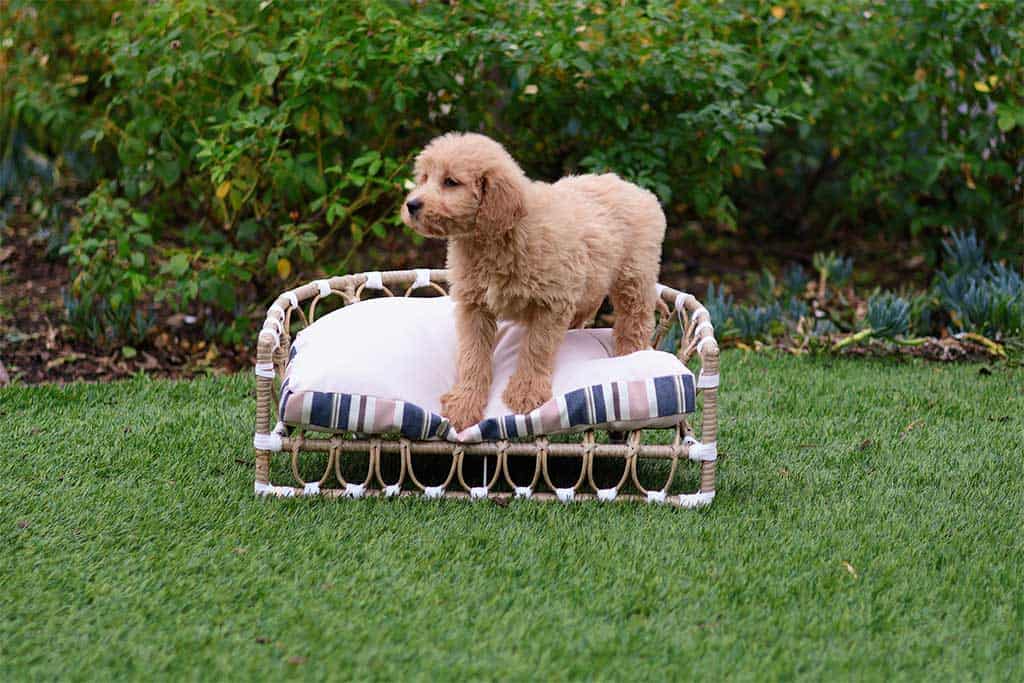Crate training is a crucial aspect of raising a well-behaved and happy puppy. Not only does it provide a cozy and secure space for your furry friend to rest and relax, but it also helps with potty training and can prevent destructive behavior when left alone. But let’s be real, one of the most challenging parts of crate training is dealing with the crying that often comes with it. As a new puppy owner, it’s natural to feel unsure about how long you should let your puppy cry before intervening.
The key is to find the perfect balance between providing the necessary discipline for your Goldendoodle puppy to teach that crying won’t get them what they want and showing them compassion and understanding during the learning process. In this article, we’ll delve into the importance of crate training and offer guidelines on how long you should let your puppy cry.
Why does my puppy cry in her crate?
When it comes to the question of why dogs cry in their crates, it’s important to understand that it’s not a calculated attempt to drive you crazy or make you lose sleep. Instead, there can be a variety of reasons behind this behavior. Some common causes include feelings of loneliness, boredom, fear, and even physical discomfort.
Additionally, it’s essential to make sure your puppy is comfortable in his crate. Provide soft blankets or a warm and cozy dog bed, as crates can be quite chilly and hard. Also, ensure that the crate is in a place that is protected from drafts, extreme temperatures, and loud noises. Some crates can make noise when the door opens or closes, so it’s a good idea to get your puppy used to that sound by opening and closing the door a few times before putting him inside.
Additionally, a sudden change in behavior, such as whining, could be a sign that your dog needs to be let out of the crate for physical reasons. It’s important to note that this type of crying is a normal part of the crate-training process and can be overcome with proper training and management techniques.

However, if the crying is accompanied by other symptoms of anxiety, such as destructive behavior, it could be a sign of separation anxiety, which requires a more comprehensive approach such as long-term management, training, and, in some cases, medication.
Is it appropriate to leave a puppy to cry in his crate?
It’s natural for puppies to feel a sense of separation anxiety when left alone, and this may manifest in the form of crying while in their crate. When asking the question should i let my puppy cry in his crate, It’s important to remember, however, that this is a normal part of the crate training process. To properly train your puppy, it’s essential to allow them to acclimate to spending short periods of time alone in their crate.
This helps them understand that being alone is not a permanent state and that you will return to them. It’s also important to note that leaving your puppy alone for extended periods of time can have negative consequences, so it’s vital to strike a balance between providing discipline and showing compassion during the training process.
When can you leave your puppy in the crate without him crying?
The process of crate training can be a delicate balance, especially when it comes to dealing with crying. While it may be tempting to immediately comfort your furry companion, it’s important to remember that allowing your puppy to cry for a short period can ultimately lead to a more well-behaved and content pup. By consistently reinforcing positive associations with the crate, such as by providing treats and praise, you’ll be able to ease your puppy’s transition and reduce the amount of crying.
Additionally, it’s important to consider the timing of your puppy’s cries and resist the urge to immediately intervene, as this can inadvertently teach them that crying leads to freedom. Instead, aim to create a routine where your puppy is able to settle down and sleep in their crate, with you ultimately being in control of when it’s time for them to come out. With patience and consistency, your puppy will soon learn that the crate is a safe and comfortable place to be.
Will my puppy ever like his crate?

With the right approach and dedication, your furry companion will come to appreciate the comfort and security of their crate. It’s essential to remember that, as den animals, dogs innately seek out a cozy space to call their own. But, before your pup can fully embrace their crate as a sanctuary, it’s crucial to establish it as a positive and safe environment.
This means avoiding using the crate as a means of punishment or extended confinement. It may be a challenge, but with patience and consistency, you’ll be able to guide your furry friend towards a newfound appreciation for their crate. If the puppy still crying at night after 3 weeks, then consider visiting a vet to get a solution.
How long to let puppy cry in crate: When to take your dog out of the crate
Training a puppy to love his crate is a process that requires both patience and persistence. As den animals, dogs find comfort in having a place of their own, but they need to be eased into it properly. It’s important to ensure that your puppy sees the crate as a safe and inviting sanctuary, rather than a cage or a tool for punishment.
One way to do this is by starting with shorter crates sessions—no more than 30 minutes to begin with. Gradually increasing the duration of the sessions as your puppy becomes more comfortable It’s also important to use positive reinforcement, such as treats, to help create positive associations with the crate.
For puppies with higher degrees of separation anxiety, it may be helpful to start by leaving the door open and allowing them to explore the crate on their own. And for those who find it more frustrating to see their people but can’t physically interact with them, try placing a blanket or toy over the crate to block their view.

It’s also important to remember that each puppy is different and may respond differently to crate training. It may take some trial and error to find the best approach for your puppy, but with time and patience, you can help them see their crate as a comfortable and secure place to call their own.
How Long Should You Let a Puppy Cry in A Crate?
If your puppy is feeling a bit uneasy, it’s best to give him some time to acclimate to his surroundings. A general rule of thumb is to start with shorter durations, such as 10 minutes, and gradually increase the time as your pup becomes more comfortable. Most puppies will settle down within a half hour of being placed in their crate.
However, it’s important to keep in mind that a puppy’s bladder is not fully developed, so they may need to go out more frequently. To avoid any accidents, make sure to take your pup out for a quick potty break before placing him in his crate. As your puppy becomes more familiar with his crate, you may notice that he whines or barks for a bit before settling down.
This is normal, as he’s adjusting to being without his pack. Over time, you’ll notice that your puppy settles down faster and faster. When you do go to comfort your pup, try to avoid playing with him, as this may prolong the settling process. Instead, take him out for a potty break if necessary, and then bring him back inside to settle back down to sleep.
How Do I Stop My Dog from whining In The Crate?
To help your furry companion feel at ease in his crate, there are a few things you can do to make the transition smoother. Proper training, providing comfort, and being mindful of his environment can all play a crucial role in helping your puppy adjust.

First and foremost, it’s important to get your pup accustomed to his new home. Crate training is a vital step in this process, as it can be a difficult transition for a puppy to be separated from his mother and littermates. Building a positive association with the crate is key. If possible, try to find a breeder who has already exposed their puppies to crates and short periods of being alone.
But if that’s not an option, start by introducing the crate to your puppy gradually. Allow him to spend time inside while eating or playing, with the door open at first. Then, as he becomes more comfortable, you can shut the door for short periods, always rewarding him with a treat when he goes inside.
Additionally, it’s essential to make sure your puppy is comfortable in his crate. Provide soft blankets or a warm dog bed, as crates can be quite chilly and hard. Also, ensure that the crate is in a place that is protected from drafts, extreme temperatures, and loud noises. Some crates can make noise when the door opens or closes, so it’s a good idea to get your puppy used to that sound by opening and closing the door a few times before putting him inside.
Lastly, make sure your puppy is relaxed around the crate before putting him inside. Let him sniff the outside and place some treats or toys inside to encourage him to go in on his own. With these steps in mind, your puppy will soon be comfortable and content in his new home.
Conclusion
In summary, proper crate training is crucial for a puppy’s well-being and development. It takes time, patience, and consistency to train your puppy to be comfortable in his crate.
By making the crate a positive place and ensuring your puppy’s comfort, you can help him feel safe and secure. It’s important to note that your puppy may cry in the crate at first, but it’s important to give him time to adjust and settle in.
However, if his cries persist for more than 30 minutes, it’s best to go to him and comfort him. Remember, every puppy is unique and may have different needs, so it’s important to understand your puppy’s individual needs and work with him at his own pace. With patience, consistency, and the right approach, your puppy will soon feel at home in his crate and be a happy, well-behaved member of your family.
If you’re curious about their development stages, read our guide on when Goldendoodles stop growing here for detailed insights.
FAQ
1. How Long Should You Let a Puppy Cry in a Crate?
It is recommended that you do not leave your pup wailing in the crate for more than 10-15 minutes. If you notice that your puppy is still crying consistently after this duration, it may be best to take a step back and focus on training exercises that help your puppy develop a positive connection with the crate.
2. How Long Will Puppy Cry First Night?
On average, a puppy will cry for a short period of around 5–10 minutes before falling asleep in his crate at bedtime. After this initial period of crying, the puppy is likely to settle down and rest for the night. Throughout the next 8 hours, it is common for puppies to wake up a few times and require a trip outside for potty breaks.
3. How Do I Get My Puppy to Stop whining in His Crate?
To help your furry companion feel at ease in his crate, there are a few things you can do to make the transition smoother. Proper training, providing comfort, and being mindful of his environment can all play a crucial role in helping your puppy adjust.
4. Can a puppy cry itself to death?
It is not possible for a puppy to die from crying alone, but it is not recommended to leave them alone while they cry. Prolonged crying can lead to the development of anxiety and behavioral issues that can last throughout a person’s life.
5. How Do I Get My Puppy to Stay in His Crate at Night?
Lead your dog to the crate and speak to him in a pleasant manner. Ensure that the crate door is securely open, so it does not accidentally hit your dog and scare him. To coax your dog into the crate, place some small food treats near it, then gradually closer to the door, and finally, inside the crate.




